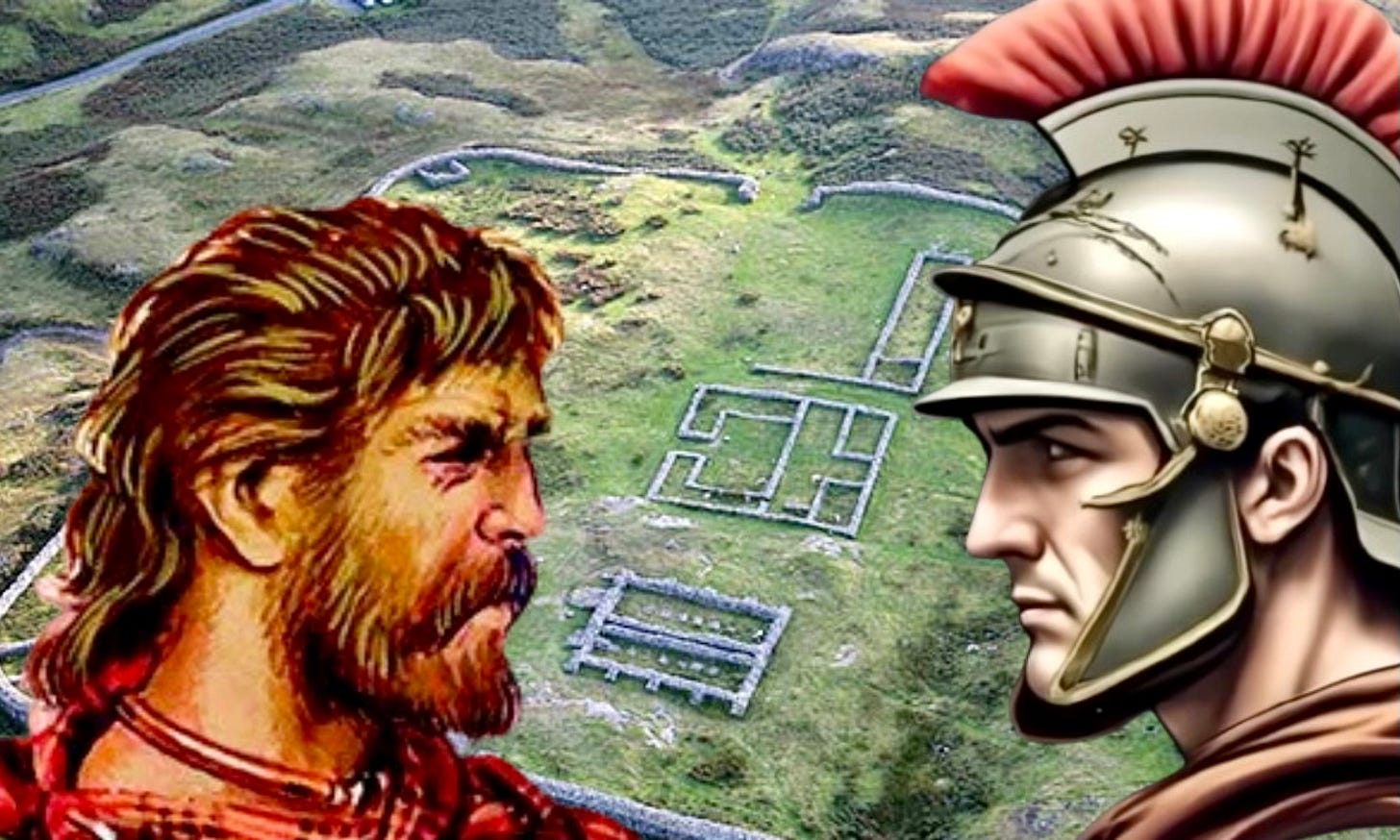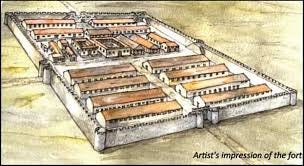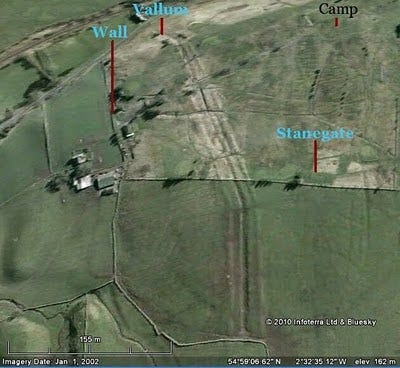Why the Romans never conquered Cumbria
Savagery of northern invasion undermined Roman hopes of pacifying Cumbrian Celts. North became militarised zone where tribes rebelled repeatedly for 300 years, fuelling legionary exit in 410 AD
Every year, half a million primary school children are told about one of the most stupendous events in history - the Roman Conquest of Britain.
One lesson plan for seven- to eleven-year-olds informs pupils that the Romans “did a lot to improve the country” when they took it over, such as building villas, installing underfloor heating and importing chickens, “Britain’s favourite meat!”
The problem is: this isn’t true. The Romans did not subdue the whole island, and it certainly did not pacify the place we now call Cumbria. Most of the luxuries promised by Roman civilisation as a reward for surrendering never reached the ordinary citizens of the north-west.
The cornerstone of Rome’s imperial policy was to invade, disarm the people and occupy conquered lands before policing them with a network of forts and roads. Then the invaders aimed to shape a public life based on Rome’s model, thereby fusing Roman and native cultures.
As the Harvard scholar Michael Jones pointed out: “Military occupation would be an expensive failure unless the natives actively co-operated with the Roman authorities in running their day-to-day affairs.” Well, there is very little evidence of the Cumbrian natives collaborating willingly with the invaders. The Romans never, as the Collins dictionary defines the word conquer, overcame or subdued Cumbria.
In fact, the best the Emperor could do was to send up to a fifth of the Imperial army to patrol Hadrian’s Wall and the north. Tying up the largest contingent of soldiers deployed anywhere in the Empire was judged only way to restrain the implacable Cumbrians. Otherwise, it was feared, they and their northern allies would join together, invade the south and end the Imperial occupation.
In the end, of course, that is exactly what the rebels did.
A crucial reason why the Cumbrians never accepted and adapted to Roman domination is the sheer savagery of the initial conquest. The root problem was the Emperors tried to acquire Britain on the cheap. By the time the general charged with subduing the north, Ganus Julius Agricola, reached the Eden Valley, he faced a desperate dilemma. His strike force was growing ever smaller because he had to keep leaving some troops behind to pacify the land just subjugated. He was denied reinforcements, so to save his own troops from dying, he had to wipe out the opposition as rapidly and ruthlessly as possible.
When the history of this period was written in 98 AD, Tacitus, Agricola’s nephew, put some famous words into the mouth of the Caledonian chieftain Calamus as he surveyed the devastation wreaked by Rome: “they make a desolation and call it peace”.
Those sentiments apply equally well to Agricola’s treatment of Cumbria. Tacitus repeatedly uses the word “terror” to describe Agricola’s campaign in northern Britain. As David Mattingly put it in his book “An Imperial Possession” the viciousness of what was done to Cumbria was unprecedented: “This was probably Roman imperialism at its fiercest and most remorseless.”
The truth is, the mighty legions that the Emperor Claudius sent to conquer Britain in 43 AD only managed to pacify the country up as far as Lindum (Lincoln). Roman fighting tactics grew more monstrous the further north they got, and therefore the intruders simply created unappeasable opposition, not future friends. The cruelty of the legionary killers rendered the north irrevocably alienated and hostile. So, the Romans handed Britain an enduring and poisonous legacy: the North-South Divide.
Eventually, the Romans were forced to institutionalise the split that their horror tactics created. Division became a permanent feature of their rule. In 197 AD the Emperor Septimius Severus designated the part below Lindum as “Britannia Superior”. This was the portion of Britain the Romans actually cared about: the rolling British lowland endowed with the richest agricultural soils. Here, a few wealthy collaborating Brits got to enjoy villas, baths and street food outlets with little military interference while life for peasants and labourers remained harsh.
The territory north of Lincoln containing Cumbria was named “Britannia Inferior”. This was cast as a hilly, stony and less fertile highland zone of military occupation. Roman Cumbria was more associated with military forts, whippings, fines and the dictatorship of an elite praetorian governor than heady imported wine and posh mosaic flooring.
Essentially, the Roman policy was to hold down Cumbria ruthlessly and stop it disrupting what the Romans regarded as the civilised south. The Roman reaction to the natives’ repeated rebellions was chilling. As the sixth century British monk Gildas wrote, the Romans were “whips for the backs of the inhabitants and a yoke for their necks.”
When we survey the gigantic stone carcasses of buildings strewn across the Cumbrian landscape, we see them as evidence the Romans established a solid, unshakeable takeover. But the ruins represent the skeleton of a huge and complex repressive machine which actually indicates the opposite.
No regime that had to build 32 Cumbrian forts, 30 miles of Hadrian’s Wall with 80 milecastles, 160 turrets and 33 interlocking military roads could be said to have been comfortably in charge.
For instance, the 15-foot-high Hadrian’s Wall had very mixed success in keeping out raiders.
When Hadrian came to the imperial throne in 117 AD the military situation in the north of Britain was spiralling out of control. Hadrian immediately sent 3,000 auxiliary reinforcements. In 122 AD he came in person at the head of a further 5,000-strong force belonging to the Sixth Legion and ordered the construction of the wall. Yet in the 180s, the Picts overtook the supposedly impregnable barrier briefly. Then, in 208, there was a massive increase in raids on the wall by Scottish tribes that endangered the entire occupation of Britain.
In response, the supremely aggressive Emperor Septimius Severus hurled an army of 50,000 men at the Caledonian tribes in a genocidal three-year campaign. He built the huge baths and administrative complex now being excavated in Carlisle as a base for the onslaught on northern Scotland aimed at eradicating all native opposition once and for all. However, the push had only limited success partly because he died before the mass slaughter was completed.
Then, in 367-8, the notoriously uncoordinated Celtic tribes finally got their act together. The Scotti from Ireland joined a grand native coalition consisting of Picts, Saxons, Franks, and the Attacotti to launch what the Romans self-pityingly called “The Barbarian Conspiracy”.
The land and sea-borne native attackers streamed over the undermanned Wall, sacked the north and west of Britain. Then, astonished to find no serious military opposition, they overran Britannia Superior and inflicted a strategic defeat that spelled the beginning of the end of the increasingly corrupt and disintegrating Imperial occupation.
So, when the Romans finally scuttled out of Britain in 410, ordinary Cumbrians had barely been affected by Roman culture. The American linguist William Dwight Whitney in 1867 invented the concept of “Romanisation” to gauge how far natives were influenced by the Roman invasion. Using his criteria, Cumbrian Celts had adopted few of the invaders’ “objects, ideas, language, religion, customs and fashion,” that Whitney included in his checklist.
Why, at least, did the Cumbrians not end up speaking Latin? It is true that a small elite group of Cumbrians adopted Christianity, the official Roman religion in 380 AD. The followers of St Patrick and St Ninian, studied Latin in Carlisle. But even Patrick admitted his Latin was poor and his first language was the Celtic tongue, Cumbric. In fact, Latin was never spoken by many people. There were fewer than 125,000 Romans Britain at any one time, up to 9,000 of them on and around the wall. Despite their varied nationalities, soldiers were expected to have a working knowledge of Latin, but they amounted to a tiny fraction of estimated the 3.6 million population, including 350,000 in Cumbria, at the end of the fourth century.
As far as the broad mass of ordinary Cumbrians was concerned, the 331-year occupation had shallow cultural roots.
Perhaps the most compelling piece of evidence that the Roman conquest of Cumbria was tenuous is the so-called Vallum. This is a huge ditch with a mound of earth either side that extends almost 73 miles from coast to coast running parallel to Hadrian’s Wall.
This channel was originally three metres deep. In its middle section it ran 700 metres from the wall. The Vallum enclosed a thick ribbon of land delineating a no-go area that ordinary Cumbrians entered at risk of death.
Now, this Vallum is a controversial earthwork. There are lots of different opinions about what exactly it was for. But the consensus is that, as archaeologist David J Breeze wrote, it was constructed to “restrict movement in the landscape”.
It seems likely that it was built on Hadrian’s orders very soon after the main wall began to take shape in the wake of what Breeze called “local opposition to the construction of the Wall”. This means there was a ferocious rebellion no doubt because the new barrier split the lands belonging to the Brigantes tribe in two leaving families divided and blocking farmers from reaching their fields.
The Vallum was designed to make it much harder to pass through the wall by reducing the number of gates from the original 80 to an estimated 14. The new ditch also meant that the duty of checking on suspicious travellers was transferred from junior soldiers below the rank of centurion and put into the hands of a regimental commander. In other words, Hadrian decided very early in the construction phase that security needed to be strengthened massively because of what today would be termed a terrorist threat.
Yet there is something very odd about the Vallum. Hadrian said he built his wall to “separate the barbarians from the Romans”. So, you would expect it to be constructed on the north side, facing the pesky Picts. But, no, the Vallum is on the south side facing the very people who were supposed to have been pacified.
What is going on? The building of this Vallum, a second layer of defence alongside the already formidable Wall, does not look like a gesture of self-confidence by the Romans. In fact, it seems to indicate nervousness that Hadrian’s Wall is more vulnerable to pressure from the home side. In other words, it looks like an admission that the conquered territory is actually riddled with furious rebels determined to link up with their dissident allies on the other side of the wall and smite the Romans, which is, of course, exactly what was to happen.
This is an extract from a forthcoming book. There are already five books in the series of Hidden Cumbrian Histories. You can buy them at The New Bookshop, Main Street, Cockermouth, Bookends in Keswick and Carlisle, along with Sam Read in Grasmere.
Buy online here: www.fletcherchristianbooks.com
TO READ THE WHOLE ARTICLE AND MORE, SIGN UP TO A PAID SUBSCRIPTION
Keep reading with a 7-day free trial
Subscribe to Hidden Cumbrian Histories to keep reading this post and get 7 days of free access to the full post archives.







